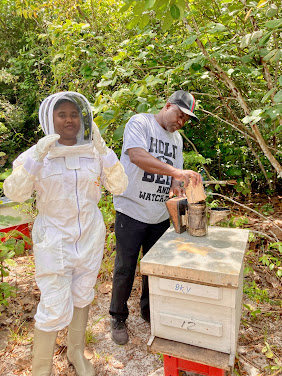Easter Bunnies!
 Partner’s AFS team wants to wish you a happy spring! To celebrate this sunny new season, we want to show some "Easter" bunnies from Haiti! Here are some highlights from
F2F’s Small Animal program, featuring these cute furry fluffs!
Partner’s AFS team wants to wish you a happy spring! To celebrate this sunny new season, we want to show some "Easter" bunnies from Haiti! Here are some highlights from
F2F’s Small Animal program, featuring these cute furry fluffs! In a recent survey completed by Partners, 74% of rabbit producers assisted by Makouti Agro Enterprise and the Farmer-to-Farmer Program report they can now afford the fees to send all of their children to school with money made from rabbit sales. Imagine the broader difference that can be made in Haiti when more families are managing small agro-enterprises, putting healthier food on the table, and sending all their children to school!
In a recent survey completed by Partners, 74% of rabbit producers assisted by Makouti Agro Enterprise and the Farmer-to-Farmer Program report they can now afford the fees to send all of their children to school with money made from rabbit sales. Imagine the broader difference that can be made in Haiti when more families are managing small agro-enterprises, putting healthier food on the table, and sending all their children to school!What does it mean to a small-scale rabbit producer in Haiti? Consider the story of Paul, from a mountain town in Haiti near the Dominican Republic border, who has 6 people in his family. On his small plot of land he grew coffee and beans, and when he started with F2F, he reported making 20,000 Haitian Gourdes (US$500) net income per year from his farming activities. That month he received 3 adult rabbits and started a F2F training program in rabbit production. Two years later, he had 18 adult rabbits with 60 offspring. He now earns 100,000 Haitian Gourdes (US$2,500) per year in net income from selling rabbits, has 8 clients in the Dominican Republic and Haiti, and has hired an employee. He takes notes of all his sales, and he also makes compost and plants trees.
One of Partners' most active rabbit volunteers - Dr. Kaplan-Pasternak - has also looked to help producers maximize their profits. She conducted trainings on adding value to rabbit by-products, namely the feet and tails that would normally be thrown away. By processing these elements and attaching them to key chains, producers can bring in an added income of up to $15 per rabbit. “Madame Alexandre and Marie Ange can now increase their profits five times, from $3 per rabbit for the meat to $18 with the 4 feet and tail beautifully set on a key chain. They are already talking about earrings and hair ornaments too. What was once a waste product is now increasing family incomes and changing lives.Those are definitely some lucky rabbit feet.”
The small animal production sector has strong potential for contributing to food security and wealth creation in much of the Caribbean Basin. For small farmers in Haiti, increased small animal production and sales translates into food for family consumption in addition to growth and diversification of family income. “




.png)

Comments
Post a Comment